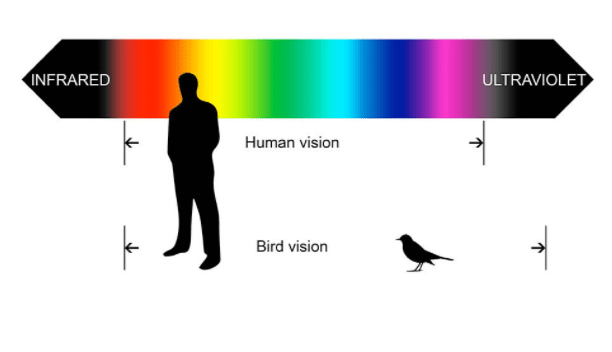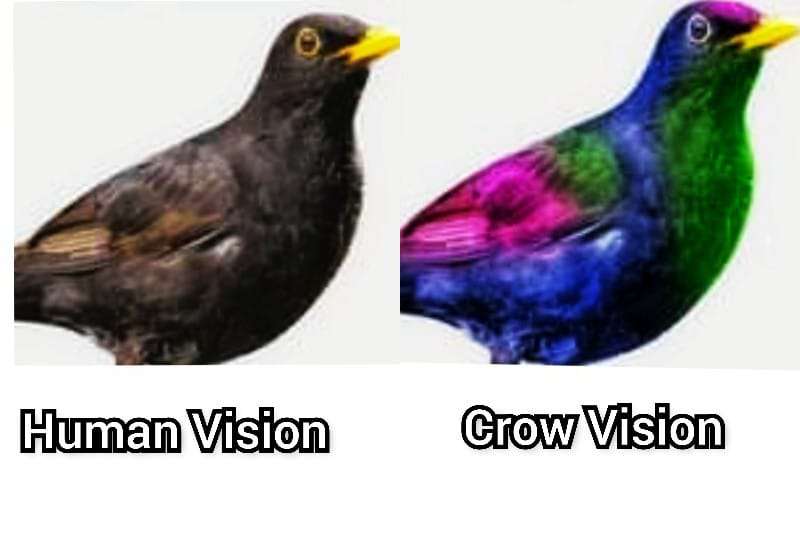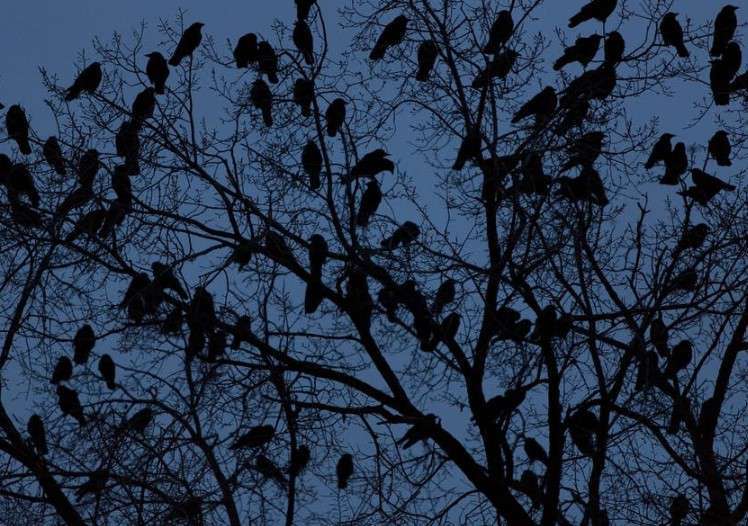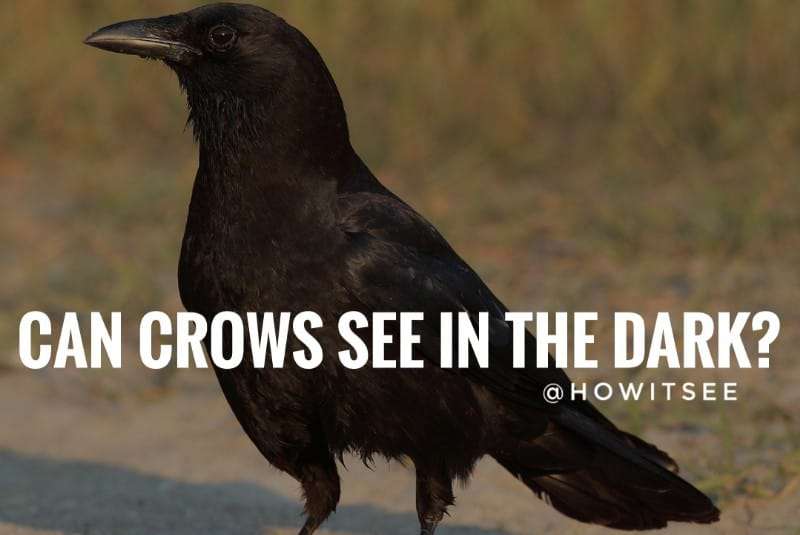Note: Both Raven and Crow share the same eyesight.
Waking up to the first rays of the sun, one of the very few sounds we hear is the cawing of the crows. Crows, one of the most commonly seen birds, belong to the genera Corvus, which belongs to a larger family Corvidae.
Seeing these birds striding with dawn often makes us wonder what these birds do at night. Sometimes we hear them cawing at night, which we associate with a bad omen. So now the question arises, “Can they see in the dark, or are they nocturnal?” Let’s find out in this article.
To answer the question, No, crows are not nocturnal birds. They are diurnal, i.e., they stay active during the day, mostly scavenging for food or perching from this place to that. Crows, unlike humans, are tetrachromatic, i.e., they can perceive combinations of four different colors. Also, they can even perceive wavelengths beyond the visible spectrum of light, like UV rays.
Crows, like other birds, possess binocular vision. Despite these evolved features, their eyes aren’t meant for night vision and are therefore not nocturnal birds. In this continued article, we have discussed some interesting facts about crows. So without further delay, let’s jump on to it.
Are Crows nocturnal?
No, crows are not nocturnal birds. Instead, they are diurnal. To understand this, let’s bridge over a couple of facts. Being nocturnal or the ability to see in the dark is directly dependent on the eye’s performance in low light conditions.
For vision in low light, the distance between the lens and the retina plays a major factor. The greater the distance, the better is the bird’s night vision. Having a short distance between their retina and lens, crow’s night vision is extremely low.
The number of cones in their eyes (responsible for light perception) is much higher than rod cells (for night vision). We might spot them sometimes at night flying here to there, but that’s just when there is a bit of light available, like street lamps. So a crow’s eyesight is not meant for night vision.
What Colors do Crows See?
Like most birds, crows are tetrachromatic. This implies that they can perceive the light of four different wavelengths. Apart from the visible spectrum of light, crows are even able to perceive Ultraviolet light, which lies beyond the visible spectrum and is invisible to the human eye.

Credits | Bird Academy
They possess’ four different kinds of cone cells, and each perceives its corresponding wavelength. So to put things together, crows see the world like us, coloration produced by three main wavelengths: blue, green, and red. In addition to this, they can even perceive the sun’s UV rays.
Are Crows colorblind?
No, crows are not colorblind. As a matter of fact, they can see far greater color shades that the human eye cannot. Color blindness is a trait often seen in nocturnal birds, as their retinas are mostly reflective to make maximum use of the minimum light available for visibility.

However, in diurnal birds like crows, the probability of finding traits like color blindness is near negligible.
How do Crows see the world?
Crows, like most birds, possess binocular vision. A crow’s binocular vision is quite large, nearly that of 60 degrees. The field of vision of each eye overlaps each other. Studies have shown that crows have one eye-sightedness. This implies that they have a preference for one eye over the other.

The single-eye vision helps the crows in different ways. Throughout evolution, crows have learned the use of various tools for multiple purposes. This has led to the development of the crow’s eyesight. These tools, for example, a stick, might be used by crows to bring out anything through thin holes or to poke into stuff.
We can understand their preferred eye by carefully watching which side of the tool they use to do their desired job. They can see far more shades of color than us humans, as they can perceive four different colors of light. Therefore, if we see an object of only one color shade, crows can see it in various other shades which are primarily imaginary to humans.
Where do Crows sleep?
As stated before, crows are diurnal birds. Therefore, they must find a shelter for them at night to protect themselves from predators, mostly consisting of owls, raccoons, etc. The place where crows stay at night is called a roost.
A roost is always a communal one. Before we jump on to where they sleep, let’s quickly go through how they choose their roost.
Firstly, a roost should be such that it provides them with sound sleep. Secondly, it should be capable enough to nest their babies and also should provide them with protection from predators.
For all these purposes, they generally choose a high place like a treetop or a window ledge of a tall building. Generally, a roost is inhabited by a flock of crows, and a case study in Illinois showed a roost that contained approximately 100,000 crows!
They usually perch themselves at the height of nearly 20-25 feet above the ground. They are also seen to roost on abandoned buildings or inside old, unused pipes.
The male and the female crow usually sleep together, mostly near their nest, so that they can tend to their fledglings whenever the need arises. Also, it has been seen that a crow will sleep in the same place.
No matter how far they go, they will return to their roost during sunset or late afternoon. The sleeping position of crows has been identified as standing-up sleeping. This is a half-sleep half-awake state, where they sleep while staying alert and can quickly react to any danger.
How do Crows see humans?
Crows see humans in many more shades than we humans see each other. Over the years, humans and crows have learned to co-exist with each other. Crows keep our surroundings clean by scavenging on wastes produced by humans directly or indirectly.
Once disregarded from the list of intelligent species, crows have now been recognized with intelligence near to primates. This co-inhabitation often leads to clashes. Studies have shown that crows remember the person who was mean to them or posed a threat.

Not only this, they can remember it for nearly five years or longer and even hold a grievance against them. A five-year-long study on this case by the University of Washington showed that crows not only hold the grievance personally but also pass it on to their flock.
An experiment was done wherein a man attempted to trap a bunch of crows and was even successful in it but released them after a few minutes. A couple of days later, nearly 20% of the crows reacted angrily to the man when he came across the same flock, and the numbers rose to 60% after 5 years, proving that the grudge had been passed on to other members of the flock.
Therefore, though crows bear no natural enmity towards humans, they remember the faces of those people who have put them under stressful situations. So next time you think of picking up a fight with a crow, remember that you might face an entire horde of them pecking at you a few years later.
Crow Vision vs Human Vision
| Crow Vision | Human Vision |
| 1. They are tetrachromats, i.e., they can perceive four different wavelengths of light, namely blue, green, red, and UV. | 1. Humans are trichromats, i.e., they can perceive three different wavelengths of light, blue, green, and red.
|
| 2. Each cone cell in crows, like other birds, contains a tiny drop of oil. This drop acts like a color that helps them to see even UV rays. | 2. No such oil droplets are found in human cone cells.
|
| 3.The binocular vision in crows is overlapping with a 60-degree arc. | 3. The binocular vision in humans is overlapping two eyes together, giving a 180-degree view arc.
|
Crow Vision vs Other Birds Vision
Crows, from class Aves, have developed certain specific traits over the years of evolution. Crow has one of the most extreme binocular vision, almost 60 degrees, whereas birds like pigeons have half of it, nearly 30 degrees.
The binocular vision is dominant in crows, while pigeons work better with their monocular vision. The dominant monocular vision implies that pigeons and parrots can focus on multiple objects at one particular moment.
Crow’s vision differs from other birds like owls, whose eyes are meant mostly to focus light through the retina for night vision. While on the other hand, a crow’s vision is primarily focused on color perception.
Here we conclude our article on “Can Crows see in the Dark or Are Crows Nocturnal? Crow Vision Explained”. Hope it has cleared all your doubts and ambiguities regarding vision in crows. We intend to bring many more such interesting articles in the future. So stay tuned, or you may read the below articles until then.
References-
Image Source- MPR News, Animalsite Facebook,
Facts about Crows
Also Read:

Meet Monty, the visionary founder of How It See, being an engineering student, he’s fueled by an insatiable curiosity about the world around him. He is captivated by an eclectic correlation between animal groups, science, and nature, and this fascination drives his quest for understanding.
After completing his degree, he’s set on a mission to delve deep into the realm of nature, accumulating knowledge to share with you through his writing. In the meantime, he loves to watch anime and read anime.

